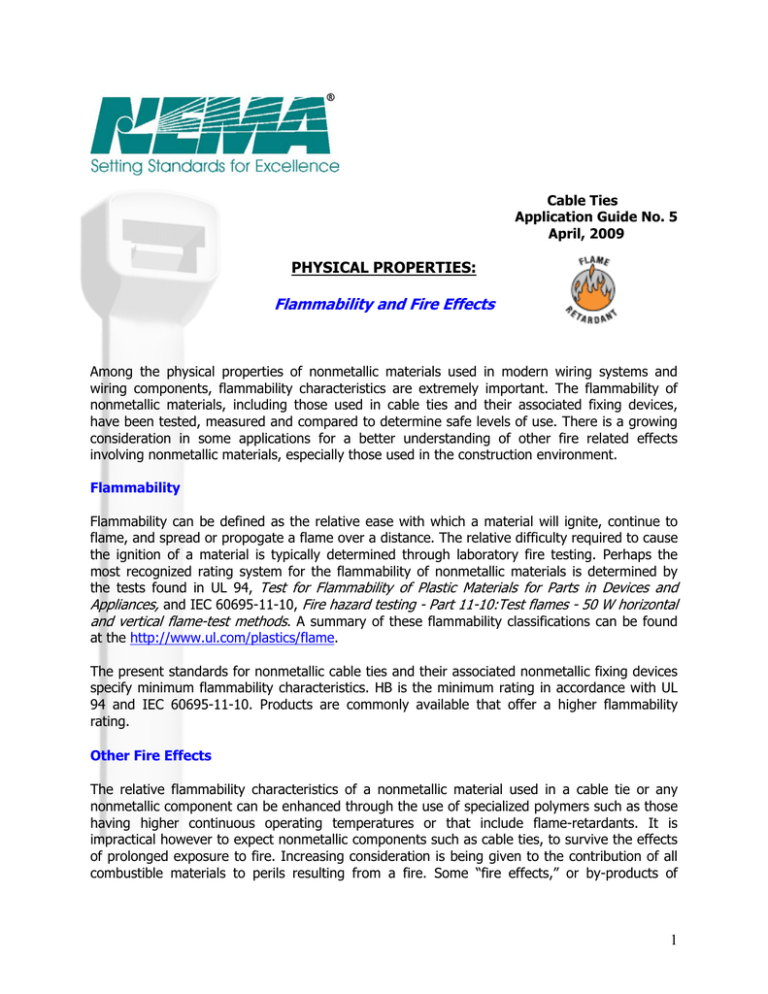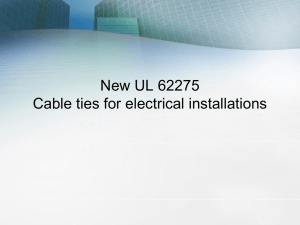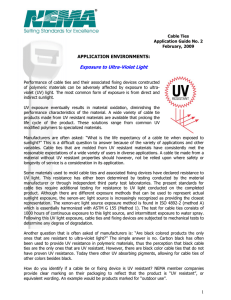Application Guide 5
advertisement

Cable Ties Application Guide No. 5 April, 2009 PHYSICAL PROPERTIES: Flammability and Fire Effects Among the physical properties of nonmetallic materials used in modern wiring systems and wiring components, flammability characteristics are extremely important. The flammability of nonmetallic materials, including those used in cable ties and their associated fixing devices, have been tested, measured and compared to determine safe levels of use. There is a growing consideration in some applications for a better understanding of other fire related effects involving nonmetallic materials, especially those used in the construction environment. Flammability Flammability can be defined as the relative ease with which a material will ignite, continue to flame, and spread or propogate a flame over a distance. The relative difficulty required to cause the ignition of a material is typically determined through laboratory fire testing. Perhaps the most recognized rating system for the flammability of nonmetallic materials is determined by the tests found in UL 94, Test for Flammability of Plastic Materials for Parts in Devices and Appliances, and IEC 60695-11-10, Fire hazard testing - Part 11-10:Test flames - 50 W horizontal and vertical flame-test methods. A summary of these flammability classifications can be found at the http://www.ul.com/plastics/flame. The present standards for nonmetallic cable ties and their associated nonmetallic fixing devices specify minimum flammability characteristics. HB is the minimum rating in accordance with UL 94 and IEC 60695-11-10. Products are commonly available that offer a higher flammability rating. Other Fire Effects The relative flammability characteristics of a nonmetallic material used in a cable tie or any nonmetallic component can be enhanced through the use of specialized polymers such as those having higher continuous operating temperatures or that include flame-retardants. It is impractical however to expect nonmetallic components such as cable ties, to survive the effects of prolonged exposure to fire. Increasing consideration is being given to the contribution of all combustible materials to perils resulting from a fire. Some “fire effects,” or by-products of 1 combustion, that may be considered include: generated heat, volume of smoke, toxicity of smoke, and corrosiveness of smoke. Listed cable ties and fixing devices that meet the requirements of UL 2043, Fire Test for Heat and Visible Smoke Release for Discrete Products and Their Accessories Installed in Air-Handling Spaces, have demonstrated characteristics for low smoke volume and heat generation under fire conditions. This qualification meets requirements in the National Electrical Code®, NFPA 70, and NFPA 90A. See NEMA Cable Ties Application Guide No. 1 for more details. All fires result in toxic smoke, regardless of the building materials involved. Carbon dioxide (CO2) and carbon monoxide (CO) are produced in all fires. CO, an odorless, colorless gas, is universally recognized to present a toxic threat in any fire situation. The hazard of gases produced when most plastics burn is similar to the hazard produced by any other burning building materials. Smoke and gases from nonmetallic cable ties are no more hazardous than those from other materials commonly used in construction and the contents of a building such as furniture, wall coverings, carpeting, drapes, wood, and paper. Wool carpeting and upholstery produce deadly hydrogen cyanide gas. Wood produces carbon monoxide, a primary cause of fire deaths. These materials ignite at a much lower temperature than nonmetallic cable ties. Concern for the corrosiveness of smoke, usually associated with materials that include halogens when exposed to fire, is a special consideration particularly in installations with sensitive electronics. Standard 66 nylons used commonly in cable ties and fixing devices are usually halogen free but when enhanced for higher continuous operating temperatures or improved flammability ratings, halogens may be introduced to the product. Similar to relative flammability characteristics, cable ties and fixing devices are available in a variety of polymeric materials with enhanced characteristics intended to address many of these “fire effects” considerations. It may be impractical however to expect any one material to optimize each of these characteristics. While there is a trend toward considering the potential aggregate impact of all combustible materials in an application environment, cable ties and fixing devices typically represent a very minor contribution to the overall “fire effects” volume of such materials in most any event. The manufacturer should always be consulted if there is a question about the proper application of a cable tie or associated fixing device. NEMA members provide high value, consistent quality, safe and efficient use for cable ties and their associated fixing devices that meet the expectations of a wide variety of users. Visit us at http://www.nema.org/prod/be/cable-ties/ for current information on our industry and for the names of NEMA cable tie manufacturers. 2 NOTICE AND DISCLAIMER The information in this publication was considered technically sound by the consensus of persons engaged in the development and approval of the document at the time it was developed. Consensus does not necessarily mean that there is unanimous agreement among every person participating in the development of this document. The National Electrical Manufacturers Association (NEMA) standards and guideline publications, of which the document contained herein is one, are developed through a voluntary consensus standards development process. This process brings together volunteers and/or seeks out the views of persons who have an interest in the topic covered by this publication. While NEMA administers the process and establishes rules to promote fairness in the development of consensus, it does not write the document and it does not independently test, evaluate, or verify the accuracy or completeness of any information or the soundness of any judgments contained in its standards and guideline publications. NEMA disclaims liability for any personal injury, property, or other damages of any nature whatsoever, whether special, indirect, consequential, or compensatory, directly or indirectly resulting from the publication, use of, application, or reliance on this document. NEMA disclaims and makes no guaranty or warranty, expressed or implied, as to the accuracy or completeness of any information published herein, and disclaims and makes no warranty that the information in this document will fulfill any of your particular purposes or needs. NEMA does not undertake to guarantee the performance of any individual manufacturer or seller’s products or services by virtue of this standard or guide. In publishing and making this document available, NEMA is not undertaking to render professional or other services for or on behalf of any person or entity, nor is NEMA undertaking to perform any duty owed by any person or entity to someone else. Anyone using this document should rely on his or her own independent judgment or, as appropriate, seek the advice of a competent professional in determining the exercise of reasonable care in any given circumstances. Information and other standards on the topic covered by this publication may be available from other sources, which the user may wish to consult for additional views or information not covered by this publication. NEMA has no power, nor does it undertake to police or enforce compliance with the contents of this document. NEMA does not certify, test, or inspect products, designs, or installations for safety or health purposes. Any certification or other statement of compliance with any health or safetyrelated information in this document shall not be attributable to NEMA and is solely the responsibility of the certifier or maker of the statement. 3


